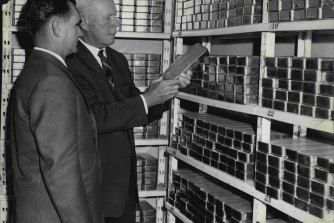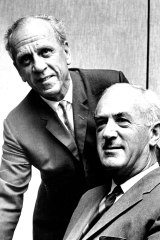From the Archives, 1960: Reserve Bank of Australia created
Federal Treasurer Harold Holt announced details of new banking regulations as the Reserve Bank of Australia took over the nation’s central banking functions.
First published in the Sydney Morning Herald on January 12 & 14, 1960
The Federal Treasurer, Mr H. E. Holt, today announced details of the new banking regulations which will come into effect with the operation of the Federal Government’s new banking legislation on Thursday.
The legislation, which passed through Federal Parliament last April, is designed to separate the administration of the central banking and non-central banking functions of the present group of Commonwealth banks.

Central banking functions will be reconstituted under the Reserve Bank of Australia.
The present Commonwealth Bank Board will become the board of the Reserve Bank.
Non-central banking will come under the control of a new organisation to be known as the Commonwealth Banking Corporation.
Brave new world of banking
(January 14, 1960)
By the Financial editor
From this morning, for the first time in 48 years, there is no Commonwealth Bank of Australia.
The name is a loss. It was a great name, in the way one presumes to apply the word great in Australia.

From the muddled beginning, the legislation of 1911 prompted, in Gibbon’s words, by “a somewhat uneasy combination of the idea of central banking and a desire to curb ‘the money power’ and nationalise the trading operations of banks.” The name, at least rose above those two contradictory schools of thought, carrying an ethos of national purpose and aspiration.
The name always managed to do that in the years of turmoil between then and now.
One cannot understand why the Canberra authorities threw tradition out the window. The separation of Commonwealth Bank functions was necessary and right. The change of name was not.
The Turbulent 1930s
Embedded in the name are long years of early Australian groping towards economic understanding. Especially in the 1930s, when bearded old Sir Robert Gibson, as governor of the bank, defied the stern advice of bearded Mr Montagu Norman not to sell off any more of his shrunken gold reserves against the note issue; when Gibson slyly manoeuvred the N.S.W. Savings Bank into his own hands; when he wrong-headedly refused to honour any more Treasury bills issued by the Federal Government of the day; when he went to the bar of the Senate and lectured the senators on the gold question, dropping a Hint that he would like to see a change of Government.
We have come a long way since then, but it is all part of the continuing tradition.
When the Commonwealth Bank was formed in 1912, it was vested only with the powers of a trading and a savings bank. The functions of a central bank were added in 1924, and already, by the crisis of 1930, Theodore, the greatest of Labour Treasurers, had recognised the inconsistency and attempted to divide the bank into two institutions, much in the way that is being done now.
The Reserve Bank of Australia, which takes over the central banking functions from today, will have a total staff of 1,800.
Though much smaller than the Commonwealth Banking Corporation with its 12,000 employees, the Reserve Bank retains an important range of duties.
Most Viewed in Business
Source: Thanks smh.com